Healthcare Assignment: Analysis of Healthcare in Australia - Nursing
VerifiedAdded on 2020/04/13
|18
|4479
|35
Homework Assignment
AI Summary
This document provides comprehensive answers to various healthcare-related questions, focusing on the Australian healthcare system. It covers key aspects such as the competency standards of the NMBA nursing practice, codes of conduct, and ethics. The assignment delves into the roles of enrolled and registered nurses, multidisciplinary healthcare teams, and traditional medicine practices in Australia. It also defines different nursing care models like functional care, primary nursing, case management, and multidisciplinary care. Furthermore, it explores concepts of health and illness, differences between primary and tertiary care, accreditation standards, nursing theories, and factors driving changes in nursing roles. The document also discusses the characteristics of the nursing profession, the roles of ANMAC and NMBA, the impact of a substandard health system, the chronic care model, and future healthcare challenges. It further examines integrated care, healthcare funding, e-health applications, the healthcare workforce, and the health status of Aboriginal and Torres Strait Islander populations. This assignment provides a thorough overview of the Australian healthcare landscape and its key components.
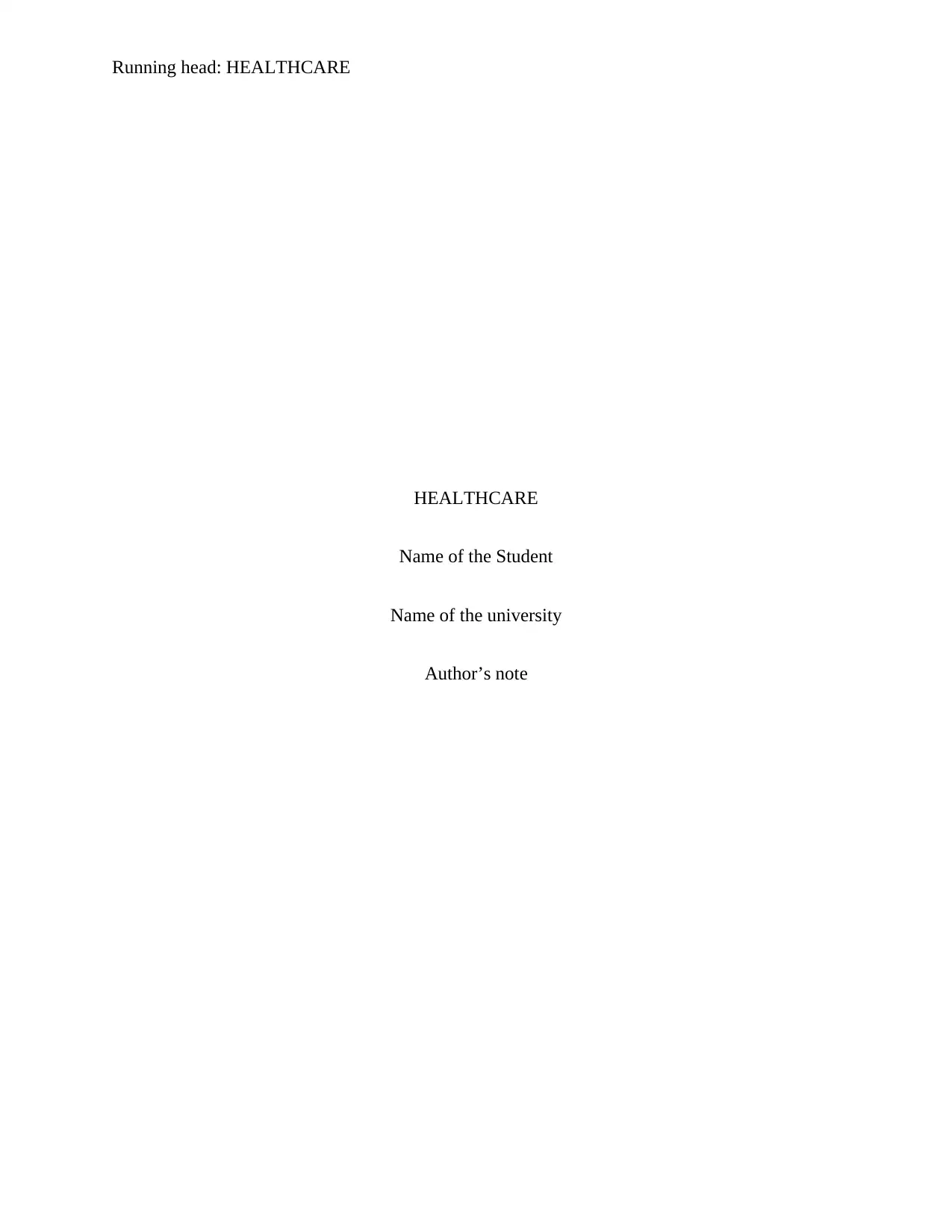
Running head: HEALTHCARE
HEALTHCARE
Name of the Student
Name of the university
Author’s note
HEALTHCARE
Name of the Student
Name of the university
Author’s note
Paraphrase This Document
Need a fresh take? Get an instant paraphrase of this document with our AI Paraphraser
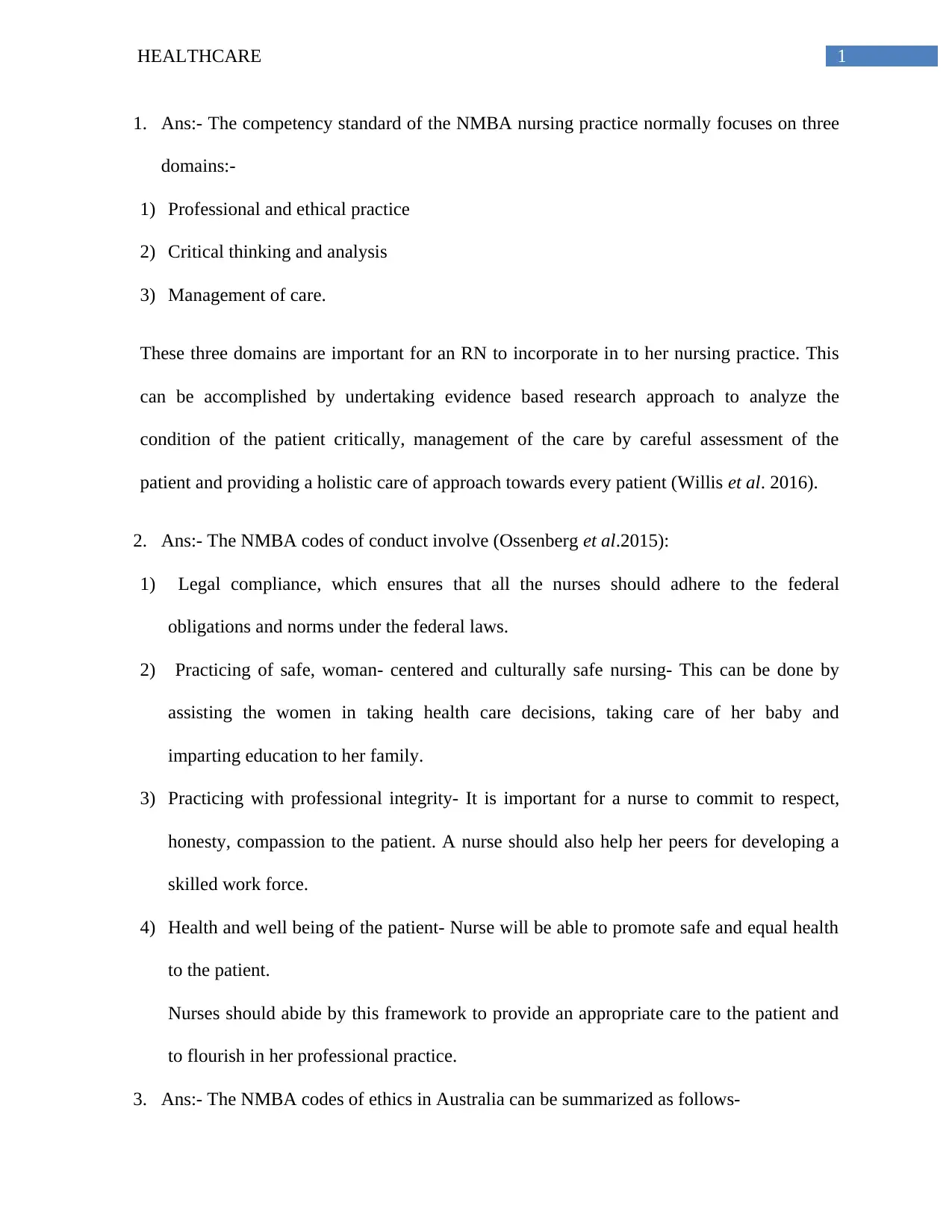
1HEALTHCARE
1. Ans:- The competency standard of the NMBA nursing practice normally focuses on three
domains:-
1) Professional and ethical practice
2) Critical thinking and analysis
3) Management of care.
These three domains are important for an RN to incorporate in to her nursing practice. This
can be accomplished by undertaking evidence based research approach to analyze the
condition of the patient critically, management of the care by careful assessment of the
patient and providing a holistic care of approach towards every patient (Willis et al. 2016).
2. Ans:- The NMBA codes of conduct involve (Ossenberg et al.2015):
1) Legal compliance, which ensures that all the nurses should adhere to the federal
obligations and norms under the federal laws.
2) Practicing of safe, woman- centered and culturally safe nursing- This can be done by
assisting the women in taking health care decisions, taking care of her baby and
imparting education to her family.
3) Practicing with professional integrity- It is important for a nurse to commit to respect,
honesty, compassion to the patient. A nurse should also help her peers for developing a
skilled work force.
4) Health and well being of the patient- Nurse will be able to promote safe and equal health
to the patient.
Nurses should abide by this framework to provide an appropriate care to the patient and
to flourish in her professional practice.
3. Ans:- The NMBA codes of ethics in Australia can be summarized as follows-
1. Ans:- The competency standard of the NMBA nursing practice normally focuses on three
domains:-
1) Professional and ethical practice
2) Critical thinking and analysis
3) Management of care.
These three domains are important for an RN to incorporate in to her nursing practice. This
can be accomplished by undertaking evidence based research approach to analyze the
condition of the patient critically, management of the care by careful assessment of the
patient and providing a holistic care of approach towards every patient (Willis et al. 2016).
2. Ans:- The NMBA codes of conduct involve (Ossenberg et al.2015):
1) Legal compliance, which ensures that all the nurses should adhere to the federal
obligations and norms under the federal laws.
2) Practicing of safe, woman- centered and culturally safe nursing- This can be done by
assisting the women in taking health care decisions, taking care of her baby and
imparting education to her family.
3) Practicing with professional integrity- It is important for a nurse to commit to respect,
honesty, compassion to the patient. A nurse should also help her peers for developing a
skilled work force.
4) Health and well being of the patient- Nurse will be able to promote safe and equal health
to the patient.
Nurses should abide by this framework to provide an appropriate care to the patient and
to flourish in her professional practice.
3. Ans:- The NMBA codes of ethics in Australia can be summarized as follows-
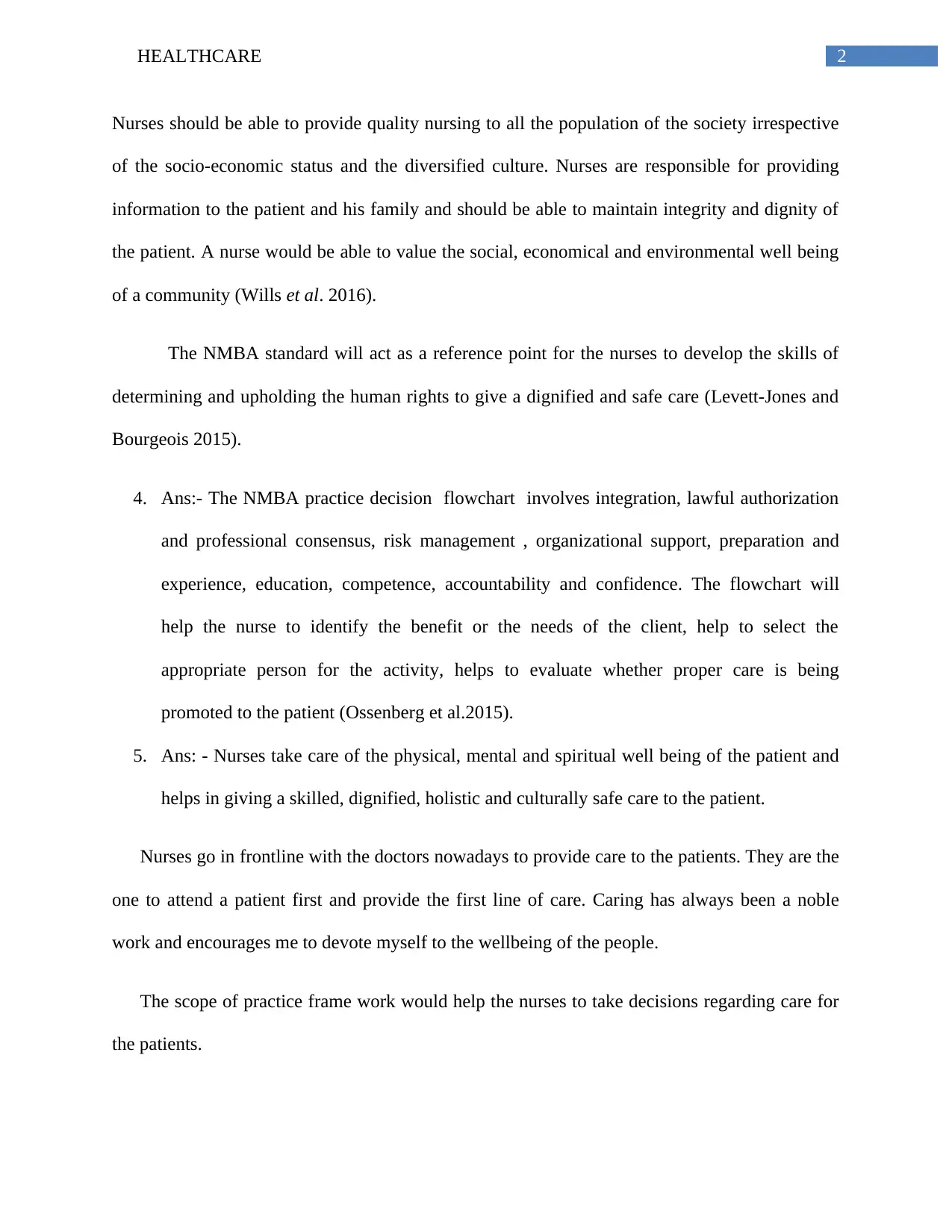
2HEALTHCARE
Nurses should be able to provide quality nursing to all the population of the society irrespective
of the socio-economic status and the diversified culture. Nurses are responsible for providing
information to the patient and his family and should be able to maintain integrity and dignity of
the patient. A nurse would be able to value the social, economical and environmental well being
of a community (Wills et al. 2016).
The NMBA standard will act as a reference point for the nurses to develop the skills of
determining and upholding the human rights to give a dignified and safe care (Levett-Jones and
Bourgeois 2015).
4. Ans:- The NMBA practice decision flowchart involves integration, lawful authorization
and professional consensus, risk management , organizational support, preparation and
experience, education, competence, accountability and confidence. The flowchart will
help the nurse to identify the benefit or the needs of the client, help to select the
appropriate person for the activity, helps to evaluate whether proper care is being
promoted to the patient (Ossenberg et al.2015).
5. Ans: - Nurses take care of the physical, mental and spiritual well being of the patient and
helps in giving a skilled, dignified, holistic and culturally safe care to the patient.
Nurses go in frontline with the doctors nowadays to provide care to the patients. They are the
one to attend a patient first and provide the first line of care. Caring has always been a noble
work and encourages me to devote myself to the wellbeing of the people.
The scope of practice frame work would help the nurses to take decisions regarding care for
the patients.
Nurses should be able to provide quality nursing to all the population of the society irrespective
of the socio-economic status and the diversified culture. Nurses are responsible for providing
information to the patient and his family and should be able to maintain integrity and dignity of
the patient. A nurse would be able to value the social, economical and environmental well being
of a community (Wills et al. 2016).
The NMBA standard will act as a reference point for the nurses to develop the skills of
determining and upholding the human rights to give a dignified and safe care (Levett-Jones and
Bourgeois 2015).
4. Ans:- The NMBA practice decision flowchart involves integration, lawful authorization
and professional consensus, risk management , organizational support, preparation and
experience, education, competence, accountability and confidence. The flowchart will
help the nurse to identify the benefit or the needs of the client, help to select the
appropriate person for the activity, helps to evaluate whether proper care is being
promoted to the patient (Ossenberg et al.2015).
5. Ans: - Nurses take care of the physical, mental and spiritual well being of the patient and
helps in giving a skilled, dignified, holistic and culturally safe care to the patient.
Nurses go in frontline with the doctors nowadays to provide care to the patients. They are the
one to attend a patient first and provide the first line of care. Caring has always been a noble
work and encourages me to devote myself to the wellbeing of the people.
The scope of practice frame work would help the nurses to take decisions regarding care for
the patients.
⊘ This is a preview!⊘
Do you want full access?
Subscribe today to unlock all pages.

Trusted by 1+ million students worldwide
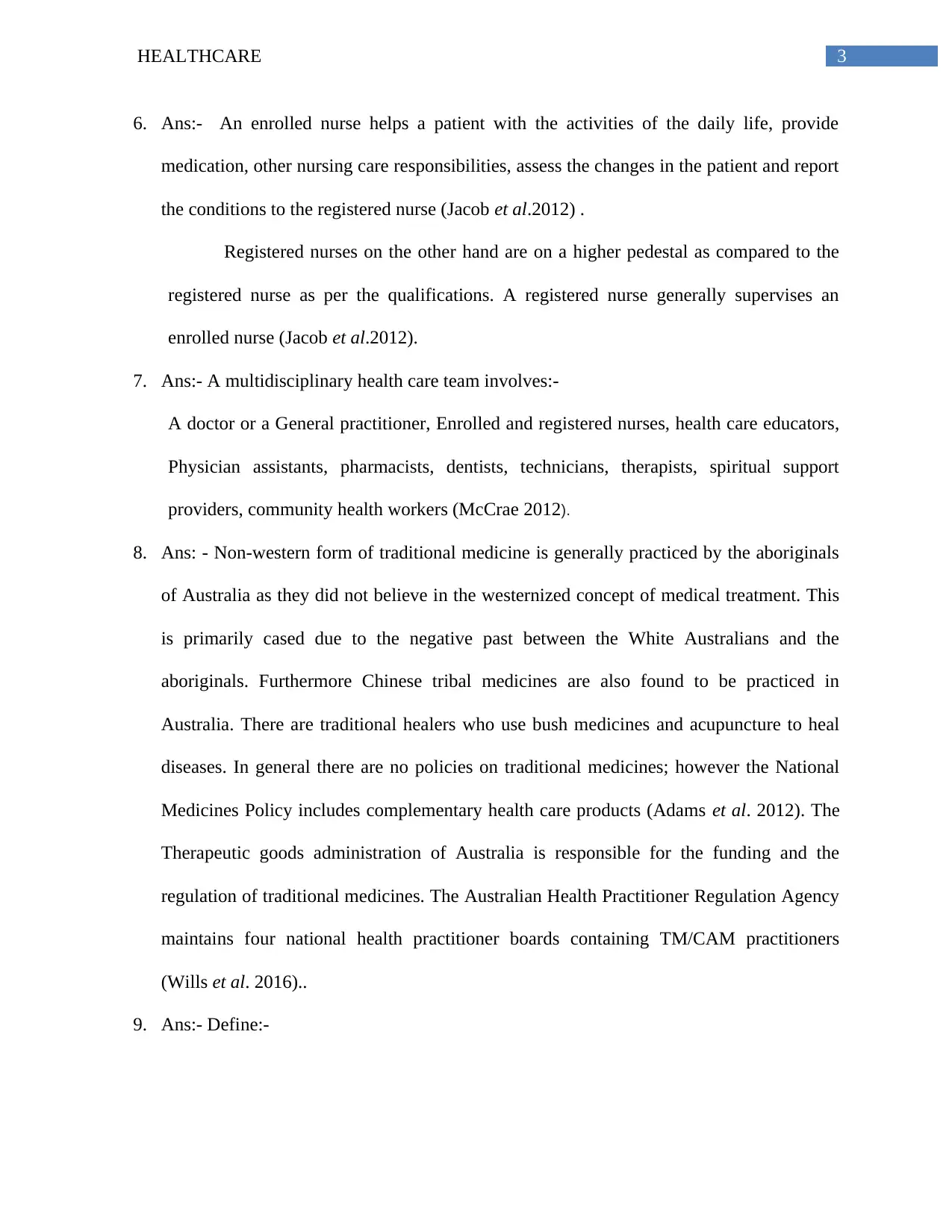
3HEALTHCARE
6. Ans:- An enrolled nurse helps a patient with the activities of the daily life, provide
medication, other nursing care responsibilities, assess the changes in the patient and report
the conditions to the registered nurse (Jacob et al.2012) .
Registered nurses on the other hand are on a higher pedestal as compared to the
registered nurse as per the qualifications. A registered nurse generally supervises an
enrolled nurse (Jacob et al.2012).
7. Ans:- A multidisciplinary health care team involves:-
A doctor or a General practitioner, Enrolled and registered nurses, health care educators,
Physician assistants, pharmacists, dentists, technicians, therapists, spiritual support
providers, community health workers (McCrae 2012).
8. Ans: - Non-western form of traditional medicine is generally practiced by the aboriginals
of Australia as they did not believe in the westernized concept of medical treatment. This
is primarily cased due to the negative past between the White Australians and the
aboriginals. Furthermore Chinese tribal medicines are also found to be practiced in
Australia. There are traditional healers who use bush medicines and acupuncture to heal
diseases. In general there are no policies on traditional medicines; however the National
Medicines Policy includes complementary health care products (Adams et al. 2012). The
Therapeutic goods administration of Australia is responsible for the funding and the
regulation of traditional medicines. The Australian Health Practitioner Regulation Agency
maintains four national health practitioner boards containing TM/CAM practitioners
(Wills et al. 2016)..
9. Ans:- Define:-
6. Ans:- An enrolled nurse helps a patient with the activities of the daily life, provide
medication, other nursing care responsibilities, assess the changes in the patient and report
the conditions to the registered nurse (Jacob et al.2012) .
Registered nurses on the other hand are on a higher pedestal as compared to the
registered nurse as per the qualifications. A registered nurse generally supervises an
enrolled nurse (Jacob et al.2012).
7. Ans:- A multidisciplinary health care team involves:-
A doctor or a General practitioner, Enrolled and registered nurses, health care educators,
Physician assistants, pharmacists, dentists, technicians, therapists, spiritual support
providers, community health workers (McCrae 2012).
8. Ans: - Non-western form of traditional medicine is generally practiced by the aboriginals
of Australia as they did not believe in the westernized concept of medical treatment. This
is primarily cased due to the negative past between the White Australians and the
aboriginals. Furthermore Chinese tribal medicines are also found to be practiced in
Australia. There are traditional healers who use bush medicines and acupuncture to heal
diseases. In general there are no policies on traditional medicines; however the National
Medicines Policy includes complementary health care products (Adams et al. 2012). The
Therapeutic goods administration of Australia is responsible for the funding and the
regulation of traditional medicines. The Australian Health Practitioner Regulation Agency
maintains four national health practitioner boards containing TM/CAM practitioners
(Wills et al. 2016)..
9. Ans:- Define:-
Paraphrase This Document
Need a fresh take? Get an instant paraphrase of this document with our AI Paraphraser
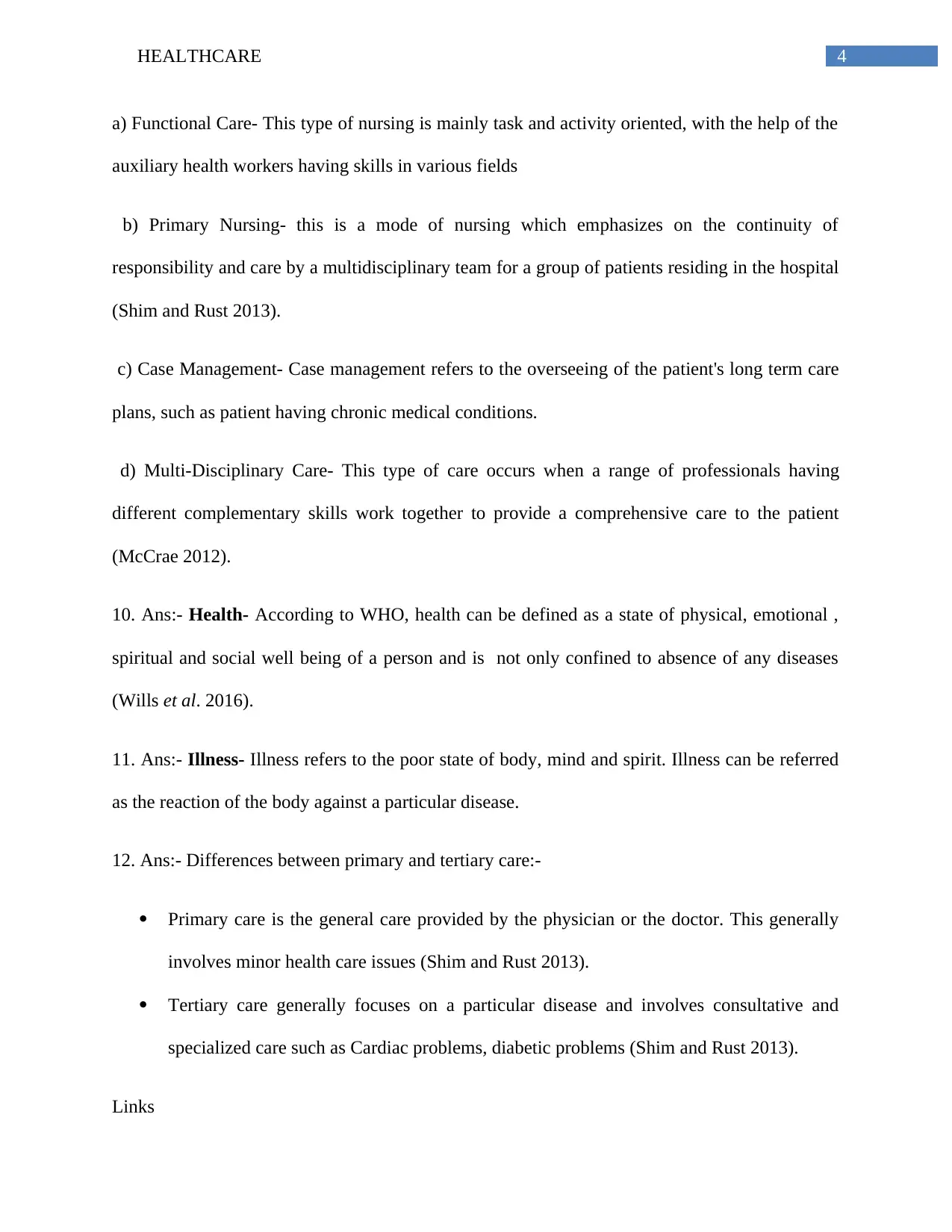
4HEALTHCARE
a) Functional Care- This type of nursing is mainly task and activity oriented, with the help of the
auxiliary health workers having skills in various fields
b) Primary Nursing- this is a mode of nursing which emphasizes on the continuity of
responsibility and care by a multidisciplinary team for a group of patients residing in the hospital
(Shim and Rust 2013).
c) Case Management- Case management refers to the overseeing of the patient's long term care
plans, such as patient having chronic medical conditions.
d) Multi-Disciplinary Care- This type of care occurs when a range of professionals having
different complementary skills work together to provide a comprehensive care to the patient
(McCrae 2012).
10. Ans:- Health- According to WHO, health can be defined as a state of physical, emotional ,
spiritual and social well being of a person and is not only confined to absence of any diseases
(Wills et al. 2016).
11. Ans:- Illness- Illness refers to the poor state of body, mind and spirit. Illness can be referred
as the reaction of the body against a particular disease.
12. Ans:- Differences between primary and tertiary care:-
Primary care is the general care provided by the physician or the doctor. This generally
involves minor health care issues (Shim and Rust 2013).
Tertiary care generally focuses on a particular disease and involves consultative and
specialized care such as Cardiac problems, diabetic problems (Shim and Rust 2013).
Links
a) Functional Care- This type of nursing is mainly task and activity oriented, with the help of the
auxiliary health workers having skills in various fields
b) Primary Nursing- this is a mode of nursing which emphasizes on the continuity of
responsibility and care by a multidisciplinary team for a group of patients residing in the hospital
(Shim and Rust 2013).
c) Case Management- Case management refers to the overseeing of the patient's long term care
plans, such as patient having chronic medical conditions.
d) Multi-Disciplinary Care- This type of care occurs when a range of professionals having
different complementary skills work together to provide a comprehensive care to the patient
(McCrae 2012).
10. Ans:- Health- According to WHO, health can be defined as a state of physical, emotional ,
spiritual and social well being of a person and is not only confined to absence of any diseases
(Wills et al. 2016).
11. Ans:- Illness- Illness refers to the poor state of body, mind and spirit. Illness can be referred
as the reaction of the body against a particular disease.
12. Ans:- Differences between primary and tertiary care:-
Primary care is the general care provided by the physician or the doctor. This generally
involves minor health care issues (Shim and Rust 2013).
Tertiary care generally focuses on a particular disease and involves consultative and
specialized care such as Cardiac problems, diabetic problems (Shim and Rust 2013).
Links
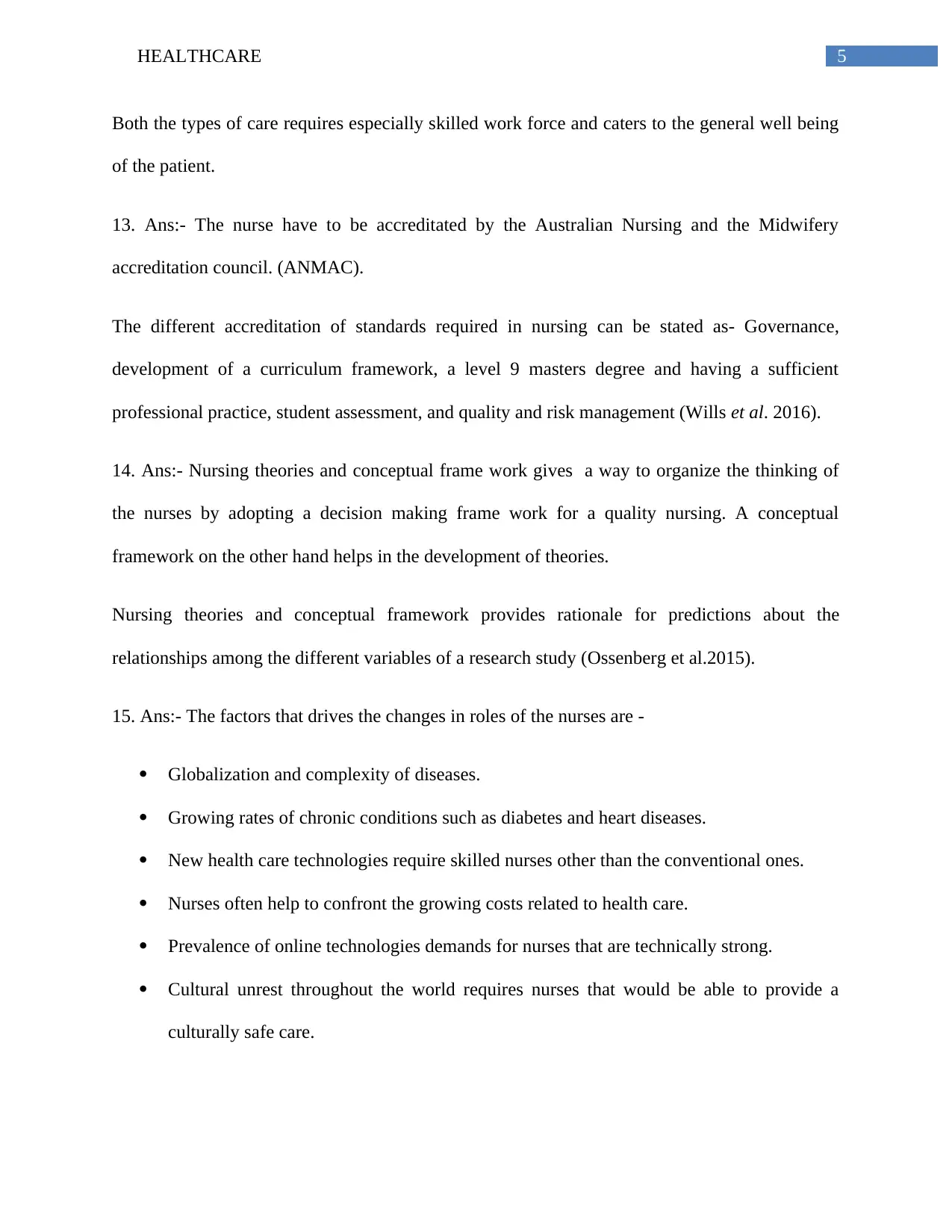
5HEALTHCARE
Both the types of care requires especially skilled work force and caters to the general well being
of the patient.
13. Ans:- The nurse have to be accreditated by the Australian Nursing and the Midwifery
accreditation council. (ANMAC).
The different accreditation of standards required in nursing can be stated as- Governance,
development of a curriculum framework, a level 9 masters degree and having a sufficient
professional practice, student assessment, and quality and risk management (Wills et al. 2016).
14. Ans:- Nursing theories and conceptual frame work gives a way to organize the thinking of
the nurses by adopting a decision making frame work for a quality nursing. A conceptual
framework on the other hand helps in the development of theories.
Nursing theories and conceptual framework provides rationale for predictions about the
relationships among the different variables of a research study (Ossenberg et al.2015).
15. Ans:- The factors that drives the changes in roles of the nurses are -
Globalization and complexity of diseases.
Growing rates of chronic conditions such as diabetes and heart diseases.
New health care technologies require skilled nurses other than the conventional ones.
Nurses often help to confront the growing costs related to health care.
Prevalence of online technologies demands for nurses that are technically strong.
Cultural unrest throughout the world requires nurses that would be able to provide a
culturally safe care.
Both the types of care requires especially skilled work force and caters to the general well being
of the patient.
13. Ans:- The nurse have to be accreditated by the Australian Nursing and the Midwifery
accreditation council. (ANMAC).
The different accreditation of standards required in nursing can be stated as- Governance,
development of a curriculum framework, a level 9 masters degree and having a sufficient
professional practice, student assessment, and quality and risk management (Wills et al. 2016).
14. Ans:- Nursing theories and conceptual frame work gives a way to organize the thinking of
the nurses by adopting a decision making frame work for a quality nursing. A conceptual
framework on the other hand helps in the development of theories.
Nursing theories and conceptual framework provides rationale for predictions about the
relationships among the different variables of a research study (Ossenberg et al.2015).
15. Ans:- The factors that drives the changes in roles of the nurses are -
Globalization and complexity of diseases.
Growing rates of chronic conditions such as diabetes and heart diseases.
New health care technologies require skilled nurses other than the conventional ones.
Nurses often help to confront the growing costs related to health care.
Prevalence of online technologies demands for nurses that are technically strong.
Cultural unrest throughout the world requires nurses that would be able to provide a
culturally safe care.
⊘ This is a preview!⊘
Do you want full access?
Subscribe today to unlock all pages.

Trusted by 1+ million students worldwide
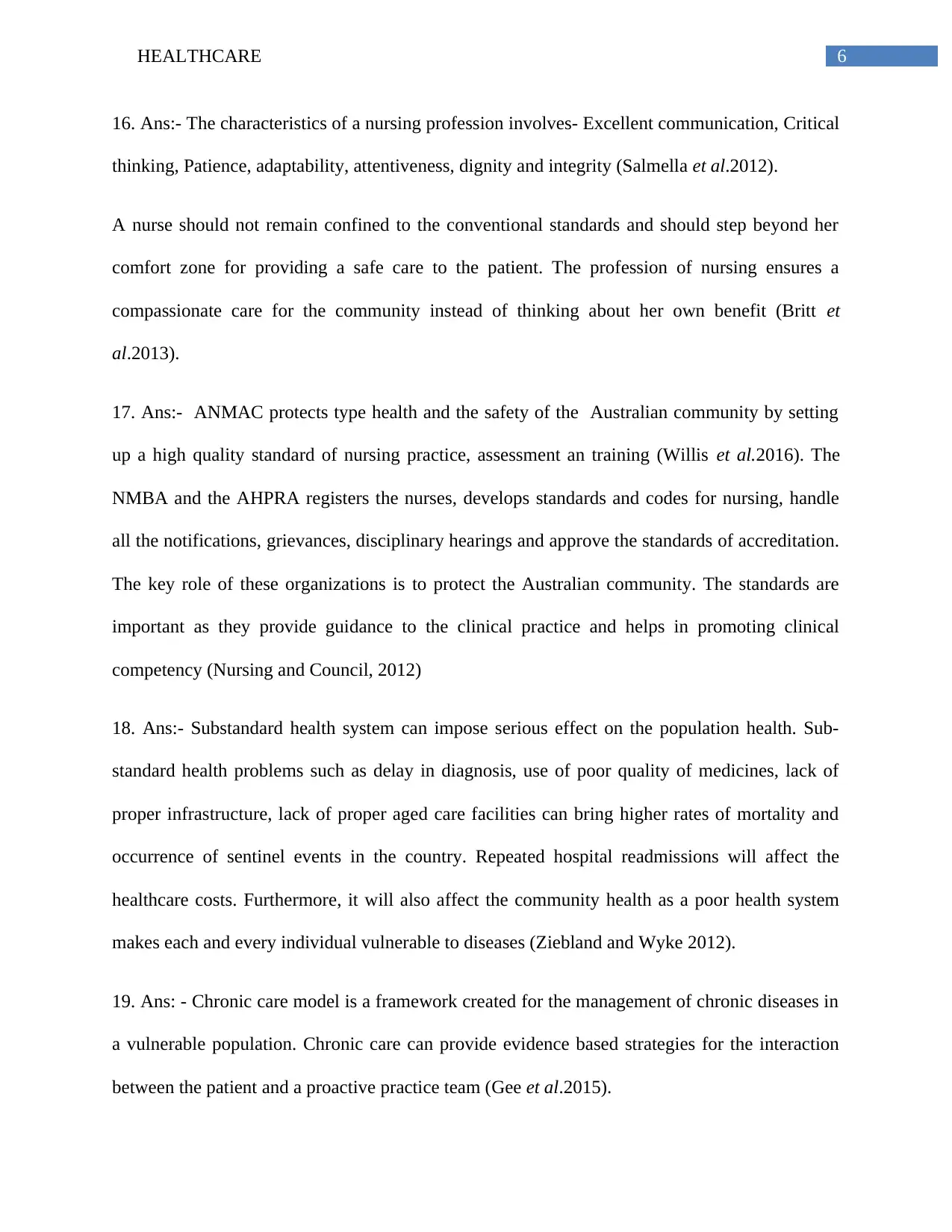
6HEALTHCARE
16. Ans:- The characteristics of a nursing profession involves- Excellent communication, Critical
thinking, Patience, adaptability, attentiveness, dignity and integrity (Salmella et al.2012).
A nurse should not remain confined to the conventional standards and should step beyond her
comfort zone for providing a safe care to the patient. The profession of nursing ensures a
compassionate care for the community instead of thinking about her own benefit (Britt et
al.2013).
17. Ans:- ANMAC protects type health and the safety of the Australian community by setting
up a high quality standard of nursing practice, assessment an training (Willis et al.2016). The
NMBA and the AHPRA registers the nurses, develops standards and codes for nursing, handle
all the notifications, grievances, disciplinary hearings and approve the standards of accreditation.
The key role of these organizations is to protect the Australian community. The standards are
important as they provide guidance to the clinical practice and helps in promoting clinical
competency (Nursing and Council, 2012)
18. Ans:- Substandard health system can impose serious effect on the population health. Sub-
standard health problems such as delay in diagnosis, use of poor quality of medicines, lack of
proper infrastructure, lack of proper aged care facilities can bring higher rates of mortality and
occurrence of sentinel events in the country. Repeated hospital readmissions will affect the
healthcare costs. Furthermore, it will also affect the community health as a poor health system
makes each and every individual vulnerable to diseases (Ziebland and Wyke 2012).
19. Ans: - Chronic care model is a framework created for the management of chronic diseases in
a vulnerable population. Chronic care can provide evidence based strategies for the interaction
between the patient and a proactive practice team (Gee et al.2015).
16. Ans:- The characteristics of a nursing profession involves- Excellent communication, Critical
thinking, Patience, adaptability, attentiveness, dignity and integrity (Salmella et al.2012).
A nurse should not remain confined to the conventional standards and should step beyond her
comfort zone for providing a safe care to the patient. The profession of nursing ensures a
compassionate care for the community instead of thinking about her own benefit (Britt et
al.2013).
17. Ans:- ANMAC protects type health and the safety of the Australian community by setting
up a high quality standard of nursing practice, assessment an training (Willis et al.2016). The
NMBA and the AHPRA registers the nurses, develops standards and codes for nursing, handle
all the notifications, grievances, disciplinary hearings and approve the standards of accreditation.
The key role of these organizations is to protect the Australian community. The standards are
important as they provide guidance to the clinical practice and helps in promoting clinical
competency (Nursing and Council, 2012)
18. Ans:- Substandard health system can impose serious effect on the population health. Sub-
standard health problems such as delay in diagnosis, use of poor quality of medicines, lack of
proper infrastructure, lack of proper aged care facilities can bring higher rates of mortality and
occurrence of sentinel events in the country. Repeated hospital readmissions will affect the
healthcare costs. Furthermore, it will also affect the community health as a poor health system
makes each and every individual vulnerable to diseases (Ziebland and Wyke 2012).
19. Ans: - Chronic care model is a framework created for the management of chronic diseases in
a vulnerable population. Chronic care can provide evidence based strategies for the interaction
between the patient and a proactive practice team (Gee et al.2015).
Paraphrase This Document
Need a fresh take? Get an instant paraphrase of this document with our AI Paraphraser
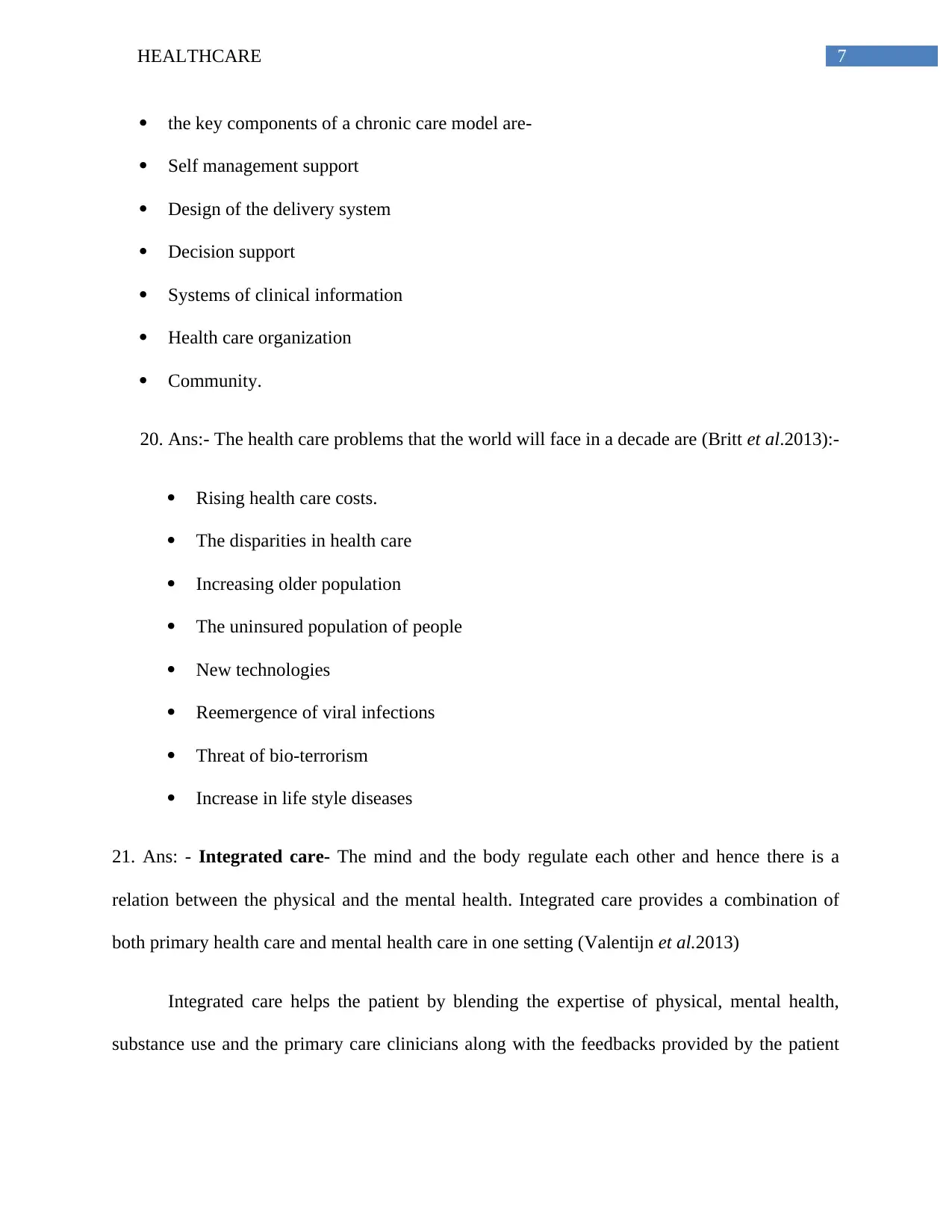
7HEALTHCARE
the key components of a chronic care model are-
Self management support
Design of the delivery system
Decision support
Systems of clinical information
Health care organization
Community.
20. Ans:- The health care problems that the world will face in a decade are (Britt et al.2013):-
Rising health care costs.
The disparities in health care
Increasing older population
The uninsured population of people
New technologies
Reemergence of viral infections
Threat of bio-terrorism
Increase in life style diseases
21. Ans: - Integrated care- The mind and the body regulate each other and hence there is a
relation between the physical and the mental health. Integrated care provides a combination of
both primary health care and mental health care in one setting (Valentijn et al.2013)
Integrated care helps the patient by blending the expertise of physical, mental health,
substance use and the primary care clinicians along with the feedbacks provided by the patient
the key components of a chronic care model are-
Self management support
Design of the delivery system
Decision support
Systems of clinical information
Health care organization
Community.
20. Ans:- The health care problems that the world will face in a decade are (Britt et al.2013):-
Rising health care costs.
The disparities in health care
Increasing older population
The uninsured population of people
New technologies
Reemergence of viral infections
Threat of bio-terrorism
Increase in life style diseases
21. Ans: - Integrated care- The mind and the body regulate each other and hence there is a
relation between the physical and the mental health. Integrated care provides a combination of
both primary health care and mental health care in one setting (Valentijn et al.2013)
Integrated care helps the patient by blending the expertise of physical, mental health,
substance use and the primary care clinicians along with the feedbacks provided by the patient
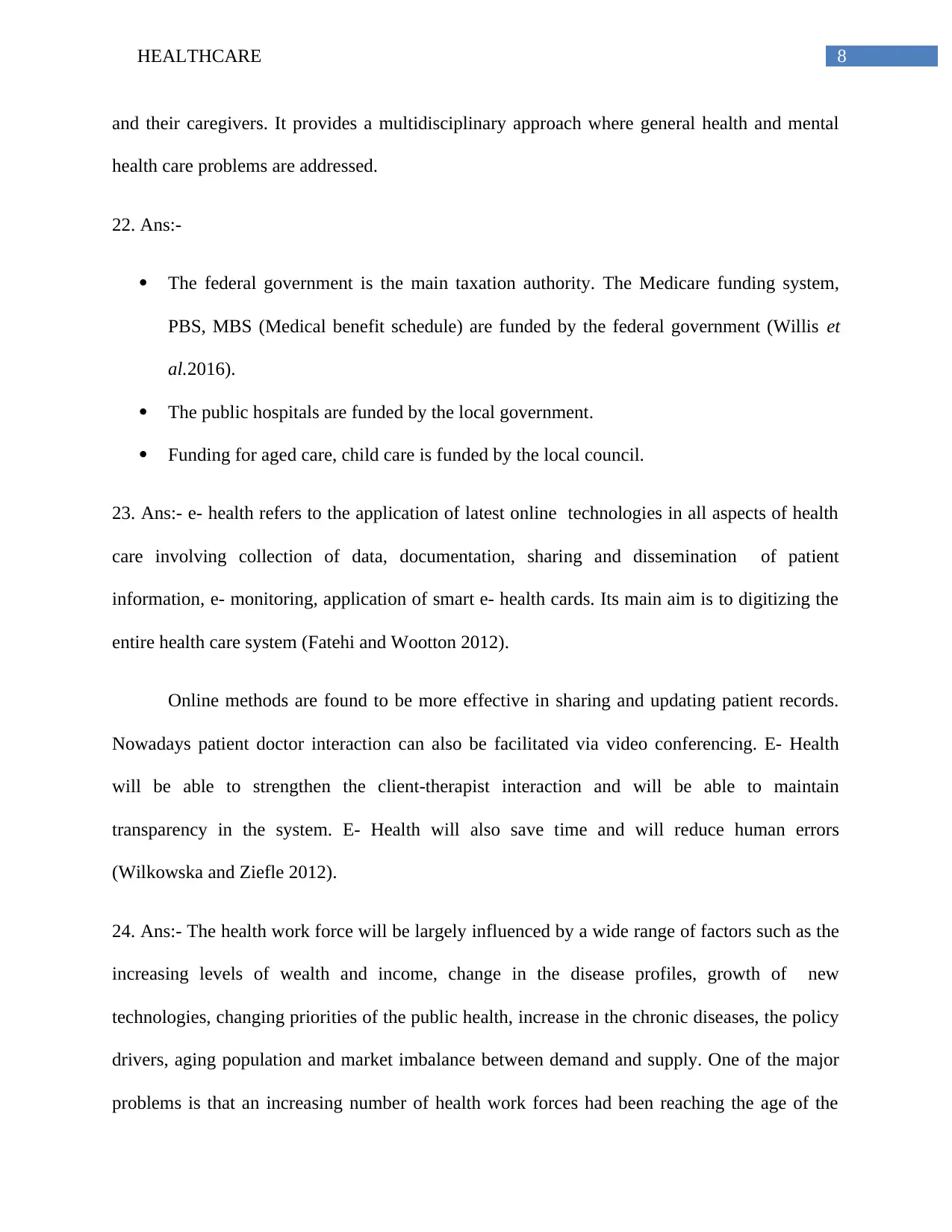
8HEALTHCARE
and their caregivers. It provides a multidisciplinary approach where general health and mental
health care problems are addressed.
22. Ans:-
The federal government is the main taxation authority. The Medicare funding system,
PBS, MBS (Medical benefit schedule) are funded by the federal government (Willis et
al.2016).
The public hospitals are funded by the local government.
Funding for aged care, child care is funded by the local council.
23. Ans:- e- health refers to the application of latest online technologies in all aspects of health
care involving collection of data, documentation, sharing and dissemination of patient
information, e- monitoring, application of smart e- health cards. Its main aim is to digitizing the
entire health care system (Fatehi and Wootton 2012).
Online methods are found to be more effective in sharing and updating patient records.
Nowadays patient doctor interaction can also be facilitated via video conferencing. E- Health
will be able to strengthen the client-therapist interaction and will be able to maintain
transparency in the system. E- Health will also save time and will reduce human errors
(Wilkowska and Ziefle 2012).
24. Ans:- The health work force will be largely influenced by a wide range of factors such as the
increasing levels of wealth and income, change in the disease profiles, growth of new
technologies, changing priorities of the public health, increase in the chronic diseases, the policy
drivers, aging population and market imbalance between demand and supply. One of the major
problems is that an increasing number of health work forces had been reaching the age of the
and their caregivers. It provides a multidisciplinary approach where general health and mental
health care problems are addressed.
22. Ans:-
The federal government is the main taxation authority. The Medicare funding system,
PBS, MBS (Medical benefit schedule) are funded by the federal government (Willis et
al.2016).
The public hospitals are funded by the local government.
Funding for aged care, child care is funded by the local council.
23. Ans:- e- health refers to the application of latest online technologies in all aspects of health
care involving collection of data, documentation, sharing and dissemination of patient
information, e- monitoring, application of smart e- health cards. Its main aim is to digitizing the
entire health care system (Fatehi and Wootton 2012).
Online methods are found to be more effective in sharing and updating patient records.
Nowadays patient doctor interaction can also be facilitated via video conferencing. E- Health
will be able to strengthen the client-therapist interaction and will be able to maintain
transparency in the system. E- Health will also save time and will reduce human errors
(Wilkowska and Ziefle 2012).
24. Ans:- The health work force will be largely influenced by a wide range of factors such as the
increasing levels of wealth and income, change in the disease profiles, growth of new
technologies, changing priorities of the public health, increase in the chronic diseases, the policy
drivers, aging population and market imbalance between demand and supply. One of the major
problems is that an increasing number of health work forces had been reaching the age of the
⊘ This is a preview!⊘
Do you want full access?
Subscribe today to unlock all pages.

Trusted by 1+ million students worldwide
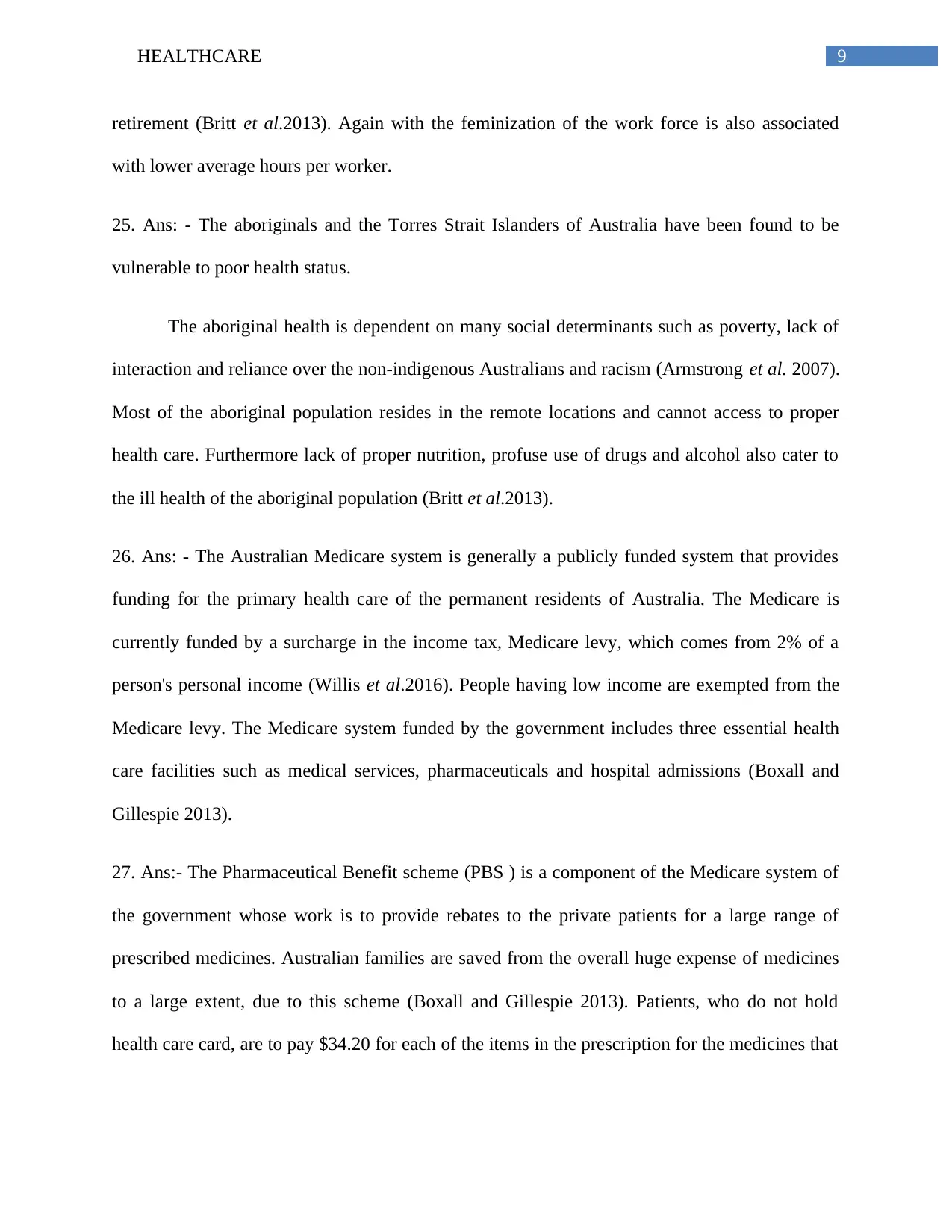
9HEALTHCARE
retirement (Britt et al.2013). Again with the feminization of the work force is also associated
with lower average hours per worker.
25. Ans: - The aboriginals and the Torres Strait Islanders of Australia have been found to be
vulnerable to poor health status.
The aboriginal health is dependent on many social determinants such as poverty, lack of
interaction and reliance over the non-indigenous Australians and racism (Armstrong et al. 2007).
Most of the aboriginal population resides in the remote locations and cannot access to proper
health care. Furthermore lack of proper nutrition, profuse use of drugs and alcohol also cater to
the ill health of the aboriginal population (Britt et al.2013).
26. Ans: - The Australian Medicare system is generally a publicly funded system that provides
funding for the primary health care of the permanent residents of Australia. The Medicare is
currently funded by a surcharge in the income tax, Medicare levy, which comes from 2% of a
person's personal income (Willis et al.2016). People having low income are exempted from the
Medicare levy. The Medicare system funded by the government includes three essential health
care facilities such as medical services, pharmaceuticals and hospital admissions (Boxall and
Gillespie 2013).
27. Ans:- The Pharmaceutical Benefit scheme (PBS ) is a component of the Medicare system of
the government whose work is to provide rebates to the private patients for a large range of
prescribed medicines. Australian families are saved from the overall huge expense of medicines
to a large extent, due to this scheme (Boxall and Gillespie 2013). Patients, who do not hold
health care card, are to pay $34.20 for each of the items in the prescription for the medicines that
retirement (Britt et al.2013). Again with the feminization of the work force is also associated
with lower average hours per worker.
25. Ans: - The aboriginals and the Torres Strait Islanders of Australia have been found to be
vulnerable to poor health status.
The aboriginal health is dependent on many social determinants such as poverty, lack of
interaction and reliance over the non-indigenous Australians and racism (Armstrong et al. 2007).
Most of the aboriginal population resides in the remote locations and cannot access to proper
health care. Furthermore lack of proper nutrition, profuse use of drugs and alcohol also cater to
the ill health of the aboriginal population (Britt et al.2013).
26. Ans: - The Australian Medicare system is generally a publicly funded system that provides
funding for the primary health care of the permanent residents of Australia. The Medicare is
currently funded by a surcharge in the income tax, Medicare levy, which comes from 2% of a
person's personal income (Willis et al.2016). People having low income are exempted from the
Medicare levy. The Medicare system funded by the government includes three essential health
care facilities such as medical services, pharmaceuticals and hospital admissions (Boxall and
Gillespie 2013).
27. Ans:- The Pharmaceutical Benefit scheme (PBS ) is a component of the Medicare system of
the government whose work is to provide rebates to the private patients for a large range of
prescribed medicines. Australian families are saved from the overall huge expense of medicines
to a large extent, due to this scheme (Boxall and Gillespie 2013). Patients, who do not hold
health care card, are to pay $34.20 for each of the items in the prescription for the medicines that
Paraphrase This Document
Need a fresh take? Get an instant paraphrase of this document with our AI Paraphraser
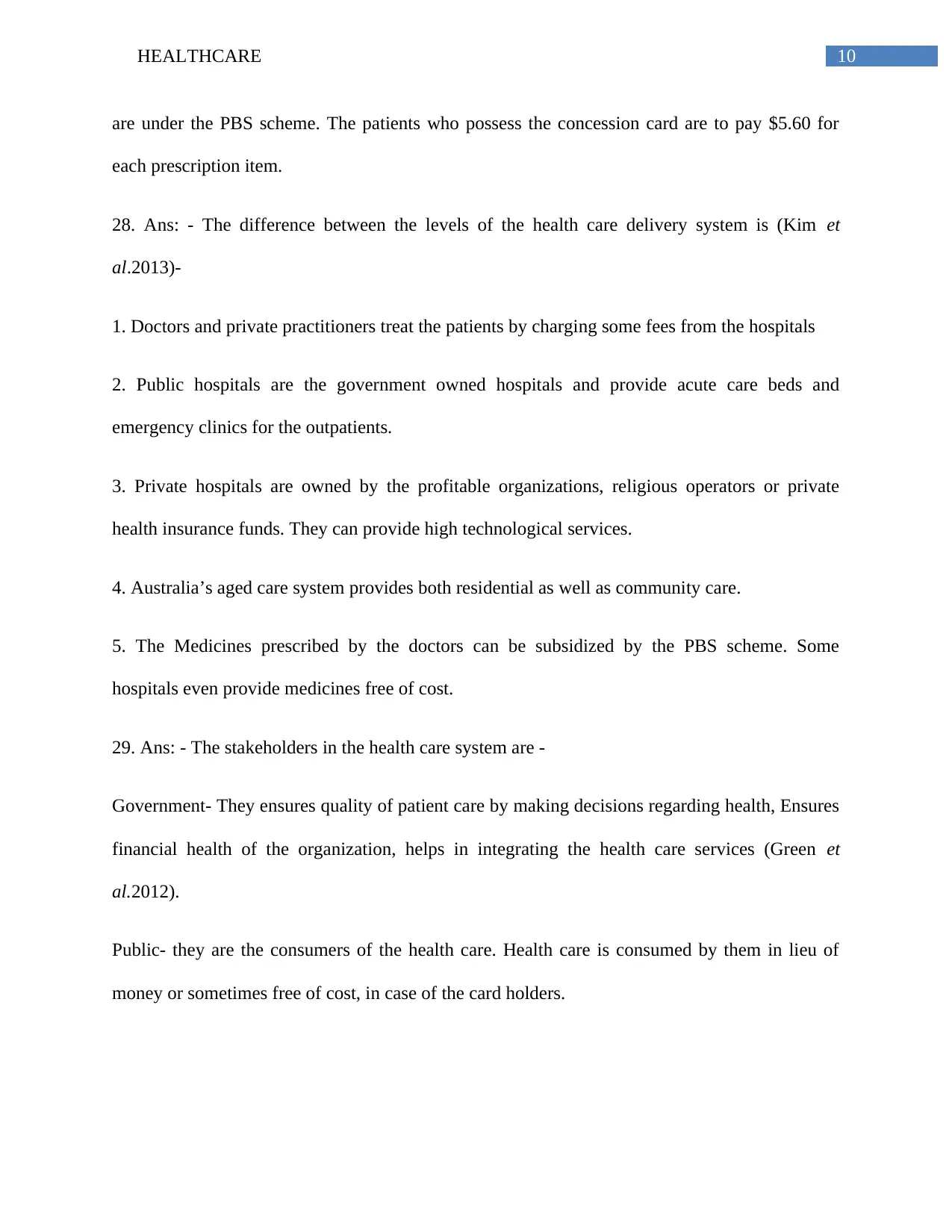
10HEALTHCARE
are under the PBS scheme. The patients who possess the concession card are to pay $5.60 for
each prescription item.
28. Ans: - The difference between the levels of the health care delivery system is (Kim et
al.2013)-
1. Doctors and private practitioners treat the patients by charging some fees from the hospitals
2. Public hospitals are the government owned hospitals and provide acute care beds and
emergency clinics for the outpatients.
3. Private hospitals are owned by the profitable organizations, religious operators or private
health insurance funds. They can provide high technological services.
4. Australia’s aged care system provides both residential as well as community care.
5. The Medicines prescribed by the doctors can be subsidized by the PBS scheme. Some
hospitals even provide medicines free of cost.
29. Ans: - The stakeholders in the health care system are -
Government- They ensures quality of patient care by making decisions regarding health, Ensures
financial health of the organization, helps in integrating the health care services (Green et
al.2012).
Public- they are the consumers of the health care. Health care is consumed by them in lieu of
money or sometimes free of cost, in case of the card holders.
are under the PBS scheme. The patients who possess the concession card are to pay $5.60 for
each prescription item.
28. Ans: - The difference between the levels of the health care delivery system is (Kim et
al.2013)-
1. Doctors and private practitioners treat the patients by charging some fees from the hospitals
2. Public hospitals are the government owned hospitals and provide acute care beds and
emergency clinics for the outpatients.
3. Private hospitals are owned by the profitable organizations, religious operators or private
health insurance funds. They can provide high technological services.
4. Australia’s aged care system provides both residential as well as community care.
5. The Medicines prescribed by the doctors can be subsidized by the PBS scheme. Some
hospitals even provide medicines free of cost.
29. Ans: - The stakeholders in the health care system are -
Government- They ensures quality of patient care by making decisions regarding health, Ensures
financial health of the organization, helps in integrating the health care services (Green et
al.2012).
Public- they are the consumers of the health care. Health care is consumed by them in lieu of
money or sometimes free of cost, in case of the card holders.
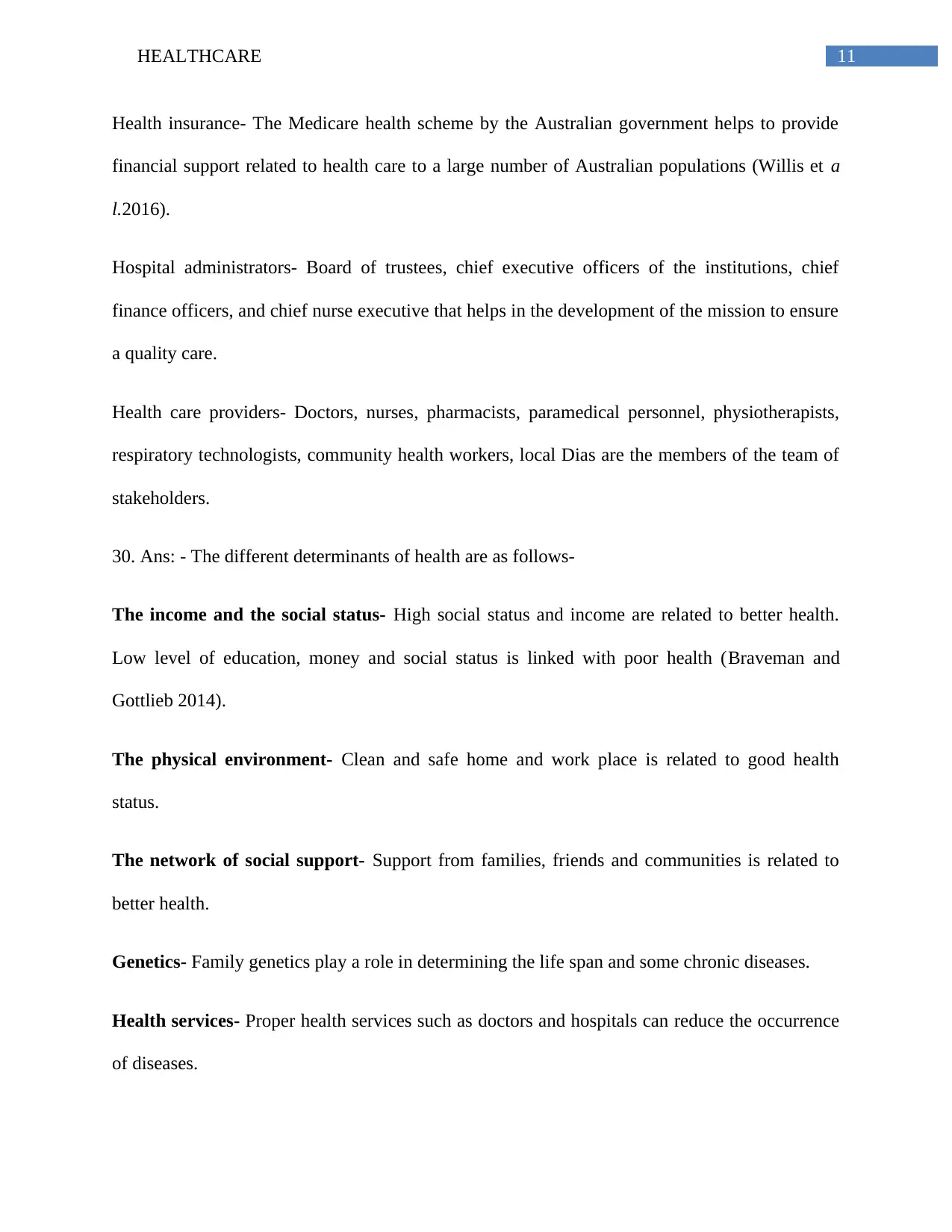
11HEALTHCARE
Health insurance- The Medicare health scheme by the Australian government helps to provide
financial support related to health care to a large number of Australian populations (Willis et a
l.2016).
Hospital administrators- Board of trustees, chief executive officers of the institutions, chief
finance officers, and chief nurse executive that helps in the development of the mission to ensure
a quality care.
Health care providers- Doctors, nurses, pharmacists, paramedical personnel, physiotherapists,
respiratory technologists, community health workers, local Dias are the members of the team of
stakeholders.
30. Ans: - The different determinants of health are as follows-
The income and the social status- High social status and income are related to better health.
Low level of education, money and social status is linked with poor health (Braveman and
Gottlieb 2014).
The physical environment- Clean and safe home and work place is related to good health
status.
The network of social support- Support from families, friends and communities is related to
better health.
Genetics- Family genetics play a role in determining the life span and some chronic diseases.
Health services- Proper health services such as doctors and hospitals can reduce the occurrence
of diseases.
Health insurance- The Medicare health scheme by the Australian government helps to provide
financial support related to health care to a large number of Australian populations (Willis et a
l.2016).
Hospital administrators- Board of trustees, chief executive officers of the institutions, chief
finance officers, and chief nurse executive that helps in the development of the mission to ensure
a quality care.
Health care providers- Doctors, nurses, pharmacists, paramedical personnel, physiotherapists,
respiratory technologists, community health workers, local Dias are the members of the team of
stakeholders.
30. Ans: - The different determinants of health are as follows-
The income and the social status- High social status and income are related to better health.
Low level of education, money and social status is linked with poor health (Braveman and
Gottlieb 2014).
The physical environment- Clean and safe home and work place is related to good health
status.
The network of social support- Support from families, friends and communities is related to
better health.
Genetics- Family genetics play a role in determining the life span and some chronic diseases.
Health services- Proper health services such as doctors and hospitals can reduce the occurrence
of diseases.
⊘ This is a preview!⊘
Do you want full access?
Subscribe today to unlock all pages.

Trusted by 1+ million students worldwide
1 out of 18
Related Documents
Your All-in-One AI-Powered Toolkit for Academic Success.
+13062052269
info@desklib.com
Available 24*7 on WhatsApp / Email
![[object Object]](/_next/static/media/star-bottom.7253800d.svg)
Unlock your academic potential
Copyright © 2020–2025 A2Z Services. All Rights Reserved. Developed and managed by ZUCOL.





